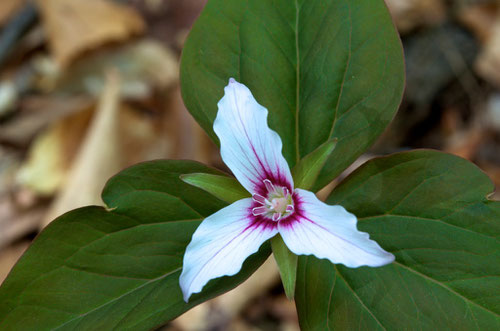Native Woodland Wildflowers

Trillium are spring ephemeral perennials. It is a genus of over 40 species native to temperate regions of North America and Asia. We have two species of Trillium growing in the woods at Distant Hill Gardens:
- Trillium undulatum - Painted Trillium or Painted Lady.
- Trillium erectum - Purple or Red Trillium, Stinking Benjamin, Wakerobin, Birthroot.
Interesting Facts About Trillium
- It is illegal to pick and/or transplant trilliums from public lands without a permit in Michigan, Minnesota and New York.
- Trillium is one of many plants whose seeds are spread by ants. Trillium seeds have a fleshy organ called an elaiosome that attracts ants. The ants take the seeds to their nest, eat the elaiosomes, and put the seeds in their garbage where they germinate.
- The above ground parts of Trilliums are scapes with three large, leaf-like bracts. The true leaves are technically the underground papery coverings around the rhizomes.
- Trillium erectum is also known as Stinking Benjamin because the flowers have the smell of rotting meat, which attracts flies as pollinators.

Dwarf Ginseng (Panax trifolius) also known as Groundnut, is a springtime herb native to eastern North America. Its distinctive tubers can be eaten raw or boiled. Native Americans drank tea made from the whole plant for medicinal purposes. It was used as a remedy for a large number of ailments, from colic to rheumatism and tuberculosis. The root was chewed for headaches, shortness of breath and fainting.
Different Soils...Different Native Plants ?
It is worth noting that Painted Trillium, which needs acidic soils to thrive, grows only on the twenty-one acres of land at Distant Hill Gardens in the town of Alstead. Both Red Trillium and Dwarf Ginseng, liking a richer soil, are found almost exclusively on the thirty-seven acres of Walpole land. Is it just that the soils are different from one town to the other? I think not.
The Alstead property has been virtually untouched by humans for at least the past 100 years. The Walpole property's forest was managed for timber and maple syrup since it first became a farm in 1790. The vegetation found on either side of the town line is like night and day. Everything we humans do, or don't do, to the land has a profound effect upon what will grow there and the health of the forest. Doing nothing is sometimes not the best course of action. In this case, the biodiversity of the property has been increased because of the difference in human interaction with these two adjacent parcels of land.

